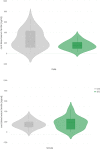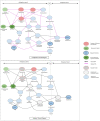Prenatal stress perturbs fetal iron homeostasis in a sex specific manner
- PMID: 35662279
- PMCID: PMC9167276
- DOI: 10.1038/s41598-022-13633-z
Prenatal stress perturbs fetal iron homeostasis in a sex specific manner
Abstract
The adverse effects of maternal prenatal stress (PS) on child's neurodevelopment warrant the establishment of biomarkers that enable early interventional therapeutic strategies. We performed a prospective matched double cohort study screening 2000 pregnant women in third trimester with Cohen Perceived Stress Scale-10 (PSS-10) questionnaire; 164 participants were recruited and classified as stressed and control group (SG, CG). Fetal cord blood iron parameters of 107 patients were measured at birth. Transabdominal electrocardiograms-based Fetal Stress Index (FSI) was derived. We investigated sex contribution to group differences and conducted causal inference analyses to assess the total effect of PS exposure on iron homeostasis using a directed acyclic graph (DAG) approach. Differences are reported for p < 0.05 unless noted otherwise. Transferrin saturation was lower in male stressed neonates. The minimum adjustment set of the DAG to estimate the total effect of PS exposure on fetal ferritin iron biomarkers consisted of maternal age and socioeconomic status: SG revealed a 15% decrease in fetal ferritin compared with CG. Mean FSI was higher among SG than among CG. FSI-based timely detection of fetuses affected by PS can support early individualized iron supplementation and neurodevelopmental follow-up to prevent long-term sequelae due to PS-exacerbated impairment of the iron homeostasis.
© 2022. The Author(s).
Conflict of interest statement
MGF holds patents on fetal ECG technologies. No other disclosures were reported.
Figures




Similar articles
-
Fetal heart rate variability responsiveness to maternal stress, non-invasively detected from maternal transabdominal ECG.Arch Gynecol Obstet. 2020 Feb;301(2):405-414. doi: 10.1007/s00404-019-05390-8. Epub 2019 Nov 28. Arch Gynecol Obstet. 2020. PMID: 31781889
-
Maternal Iron Status Is Dynamic Throughout Pregnancy and Might Predict Birth Outcomes in a Sex Dependent Manner: Results from the Alberta Pregnancy Outcomes and Nutrition (APrON) Cohort Study.J Nutr. 2023 Sep;153(9):2585-2597. doi: 10.1016/j.tjnut.2023.06.042. Epub 2023 Jun 29. J Nutr. 2023. PMID: 37393033
-
Dietary Iron Fortification Normalizes Fetal Hematology, Hepcidin, and Iron Distribution in a Rat Model of Prenatal Alcohol Exposure.Alcohol Clin Exp Res. 2018 Jun;42(6):1022-1033. doi: 10.1111/acer.13754. Epub 2018 May 19. Alcohol Clin Exp Res. 2018. PMID: 29672865 Free PMC article.
-
Prenatal alcohol-related alterations in maternal, placental, neonatal, and infant iron homeostasis.Am J Clin Nutr. 2021 Sep 1;114(3):1107-1122. doi: 10.1093/ajcn/nqab165. Am J Clin Nutr. 2021. PMID: 34091657 Free PMC article.
-
Maternal Iron Status in Pregnancy and Child Health Outcomes after Birth: A Systematic Review and Meta-Analysis.Nutrients. 2021 Jun 28;13(7):2221. doi: 10.3390/nu13072221. Nutrients. 2021. PMID: 34203528 Free PMC article.
Cited by
-
Maternal prenatal stress induces sex-dependent changes in tRNA fragment families and cholinergic pathways in newborns.Mol Psychiatry. 2025 Sep;30(9):4307-4319. doi: 10.1038/s41380-025-03011-2. Epub 2025 Apr 5. Mol Psychiatry. 2025. PMID: 40188313 Free PMC article.
-
Determinants of the Association Between Maternal Anemia and Neonatal Hemoglobin.Nutrients. 2025 Jul 11;17(14):2292. doi: 10.3390/nu17142292. Nutrients. 2025. PMID: 40732917 Free PMC article.
-
Combined Restraint Stress and Metal Exposure Paradigms in Rats: Unravelling Behavioural and Neurochemical Perturbations.Mol Neurobiol. 2025 Apr;62(4):4355-4376. doi: 10.1007/s12035-024-04570-1. Epub 2024 Oct 24. Mol Neurobiol. 2025. PMID: 39443350
-
Detection of maternal and fetal stress from the electrocardiogram with self-supervised representation learning.Sci Rep. 2021 Dec 17;11(1):24146. doi: 10.1038/s41598-021-03376-8. Sci Rep. 2021. PMID: 34921162 Free PMC article. Clinical Trial.
-
Maternal-fetal stress and DNA methylation signatures in neonatal saliva: an epigenome-wide association study.Clin Epigenetics. 2022 Jul 14;14(1):87. doi: 10.1186/s13148-022-01310-x. Clin Epigenetics. 2022. PMID: 35836289 Free PMC article.
References
Publication types
MeSH terms
Substances
LinkOut - more resources
Full Text Sources

